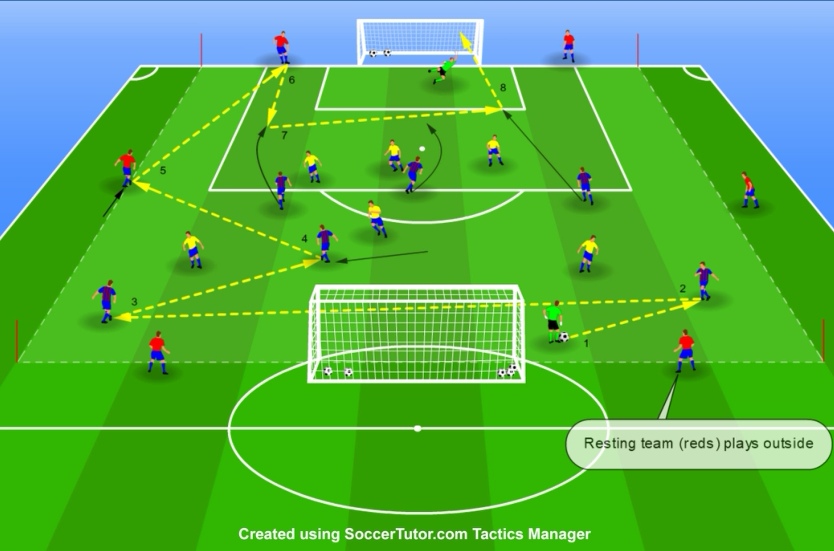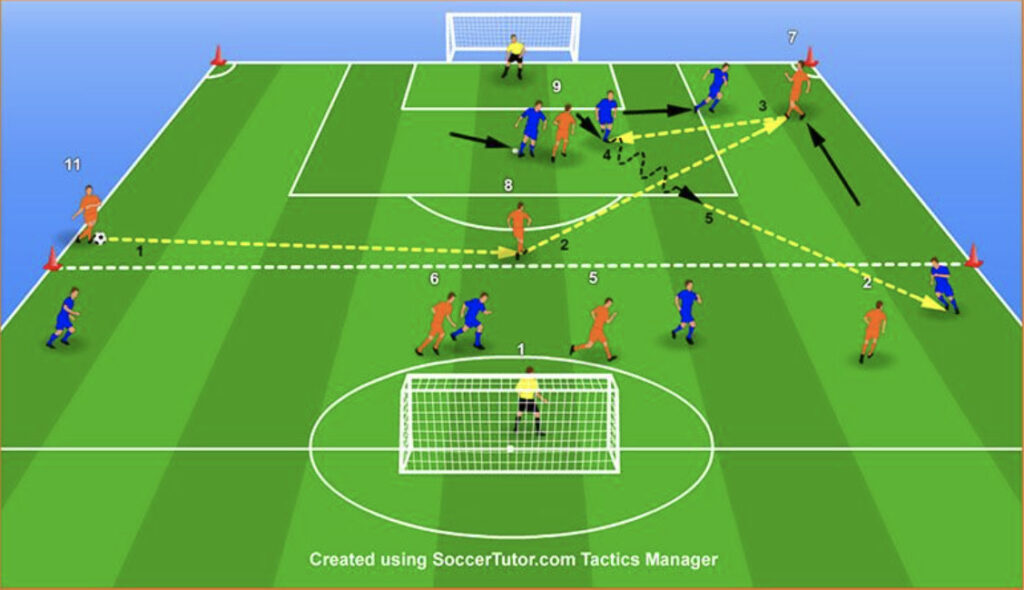Small sided games (SSGs) have grown in popularity in recent years among football coaches. The specific drill has a smaller playing field and fewer players on the field, usually 3 to 7 players per team. Goalkeepers are not always required to play in SSGs, which are frequently utilized as a training type of drill to enhance abilities and tactical awareness.
Table of Contents
One of the primary reasons for the growing popularity of SSGs is that they provide a more realistic and game-like environment for players to develop their skills. SSGs give the opportunity to players, especially to young ones, to work on a range of skills in a dynamic and unpredictable environment, in contrast to traditional methods of training where players may do drills or exercises alone. Players can improve their performance by practicing their passing, dribbling, shooting, and defensive techniques in a realistic game environment.
The encouragement of communication and teamwork among players is another significant advantage of SSGs. Every player in a small-sided game has greater impact on the drill’s outcome, therefore for teams to win, communication and teamwork are essential. This may promote a sense of unity among the players and enhance their knowledge of one another’s talents and shortcomings, both of which are beneficial on game day.
SSGs provide coaches with a number of useful advantages in addition to the advantages for players and teams. For instance, they are simpler to set up and maintain because they need less space and less players than standard 11-a-side games. SSGs can be modified to emphasize on specific skills or tactics and can be adjusted to accommodate participants of various ages and skill levels.
Overall, the growing popularity of SSGs in soccer coaching reflects a shift towards more player-centred and game-like training methods. By providing a fun and dynamic environment for players to develop their skills and work together as a team, SSGs offer a range of benefits for both players and coaches alike. In the following sections, we will explore the specific benefits of SSGs in more detail, and consider how they can be used to improve performance on match day.
What are small sided games?
SSGs are simply soccer games played on a smaller field with less players. Small-sided games, in contrast to traditional soccer training drills, put an emphasis on generating game-like scenarios that let players hone their talents in a more natural setting. These fast-paced, action-packed games demand fast thinking, quick judgments, and teamwork from the players and everything are done with the ball.
The most common sizes and formats for small-sided games are 3v3, 4v4, 5v5, and 7v7. Players are able to touch the ball more frequently in the small-sided format, which is crucial for skill development.
The Benefits of Small Sided Games
Football, or soccer as it is known elsewhere in the world, is a game that calls for a combination of talent, physical fitness, and tactical understanding. SSGs are one method for developing these qualities. SSGs reduce the duration of the game, the number of players on each team, and the size of the playing pitch. This article examines the many advantages of SSGs for coaching and player development and offers examples of how these games can help players develop their abilities and realize their full potential.
- Increased touches on the ball : One of the most significant benefits of SSGs is that players get more touches on the ball. With fewer players on the pitch, each player has more opportunities to control, dribble, and pass the ball. This increased repetition of basic skills leads to improved technique and a better understanding of the soccer game.
- Improved decision-making skills : SSGs help players develop their decision-making skills. With limited time and space, players must make quick decisions about when to pass, dribble, or shoot. This pressure improves players’ ability to read the game and make decisions under pressure.
- Enhanced communication and team spirit: SSGs promote communication and teamwork. With no so many players on the pitch, it is easier to hear and communicate with teammates. This leads to more effective teamwork and a better understanding of each other’s strengths and weaknesses.
- Higher fitness levels : SSGs are an excellent way to improve players’ fitness levels. With more opportunities to touch the ball, players must constantly move and change direction, leading to a high-intensity workout. Moreover, the smaller pitch size means that players are always close to the action, and there are minimum breaks in play, leading to a more demanding physical workout. Soccer is a high intensity game and players must have an excellent fitness condition.
- Greater tactical awareness : Finally, SSGs improve players’ tactical awareness. With not so many players on the pitch, each player has a more significant impact on the game’s outcome. This forces players to think more strategically about their position and how they can contribute to their team’s success.
- Fun and Engaging: SSGs are a fun and engaging way to train. Players enjoy the competition and teamwork involved, and this makes practises more enjoyable and effective.
SSGs are the future of football. These games offer numerous benefits for player development and coaching, including increased touches on the ball, improved decision-making skills, enhanced communication and teamwork, higher fitness levels, and greater tactical awareness. By incorporating SSGs into training days, coaches can help players and the team in general to improve their skills and reach their potential.
The Different Formats of Small Sided Games
- 3v3 SSGs
- The smallest type of small-sided game is 3v3. Each team has three players and plays on a small pitch with two or more goals. Playing these games is an excellent way to improve your shooting, passing, dribbling, and ball control abilities. They also call for effective teamwork and communication among players.
- 4v4 SSGs
- Four players make up each team in 4v4 games, which are played on a slightly larger pitch. They are a well-liked youth football format and are excellent for developing tactical abilities like positioning and teamwork. Players must be creative and think outside the box when playing these games.
- 5v5 SSGs
- Five players compose each team in 5v5 games, which are played on a somewhat bigger field. These games are fantastic for enhancing both tactical and technical abilities. Players must be physically fit and have greater mobility than in lesser formats.
- Other Formats
- There are numerous variations for small-sided games, such as 6v6, 7v7, 8v8, and even 9v9. Due to the larger fields used for these games, players must be even more physically fit and tactically astute. They are excellent for improving players’ all-around abilities and getting them ready for actual games. Each team can have also the GK as to make it more realistic with shoots for goals.
An example of a SSG is the Part 3 of “ How to Create a back 3 in the build-up “
Below are some examples of small sided games taken directly from “Pep Guardiola – 85 Passing, rondos, Possession & Technical Circuits direct from Pep’s training sessions”


Examples of how SSGs can help players improve their skills and reach their potential:
- 4v4 or 5v5 games in a small area of the pitch can help players develop their dribbling, passing, and shooting skills while also improving their decision-making skills.
- 7v7 or 8v8 games on a reduced pitch size can help players develop their tactical awareness and teamwork skills while also improving their fitness levels. GKs can be used to give the players the motivation to score a goal.
- 3v3 or 4v4 games with a small goal can help players develop their attacking and defending skills while also improving their communication skills.
Tips for Incorporating Small Sided Games into Your Training Sessions
- Choose the Right Game Format: The game format that best meets the requirements of the players should be chosen by the coaches. For instance, younger players may benefit more from 3v3 or 4v4 players in each team, whereas older or more experienced players may benefit more from 5v5 or 7v7 games.
- Modify Rules to Suit Your Players: In order to meet the needs of their players, coaches should alter the game’s rules. For instance, making the field smaller or utilizing a smaller ball can facilitate play for novice or younger players.
- Incorporate SSGs into Regular Training Days: SSGs should be incorporated almost on daily basis to ensure players are getting enough practice time. Coaches should aim to include at least one SSG in every session.
- Focus on Player Development: SSGs should be used by coaches to improve player development. This entails motivating athletes to take chances, make errors, and learn from their mistakes. Players should receive advice from coaches both during and after a game.
The Dutch Football Academies and in general any Dutch coach who respects himself, are the best examples to follow due to their focus on individual player development. Any coach interested to provide the best environment to his players should read “Dutch Academy Football Coaching U10 – U15“.

Conclusion
First and foremost, SSGs give players during play time more chances to touch the ball, which improves technical ability, creativity, and ball confidence. Players’ decision-making abilities and general game understanding may be enhanced by the need to act quickly and intelligently in limited circumstances.
Secondly, small-sided games improve fitness levels due to the high intensity nature of the games. Players are constantly running, making sharp movements and changing direction, which can increase endurance, speed and agility.
Furthermore, small-sided games promote teamwork and communication skills as players must work together to achieve a common goal. Players also develop leadership skills, as they often take on more responsibility in smaller teams.
Overall, small-sided games offer a fun and engaging way for players to improve their skills and development. They are also more inclusive, as they can be played by smaller groups of players with less space and equipment. As such, it is no surprise that more and more coaches are incorporating SSG into their training programs. Any coach can utilize the SSGs to further develop his player’s technical, physical and mental abilities.

